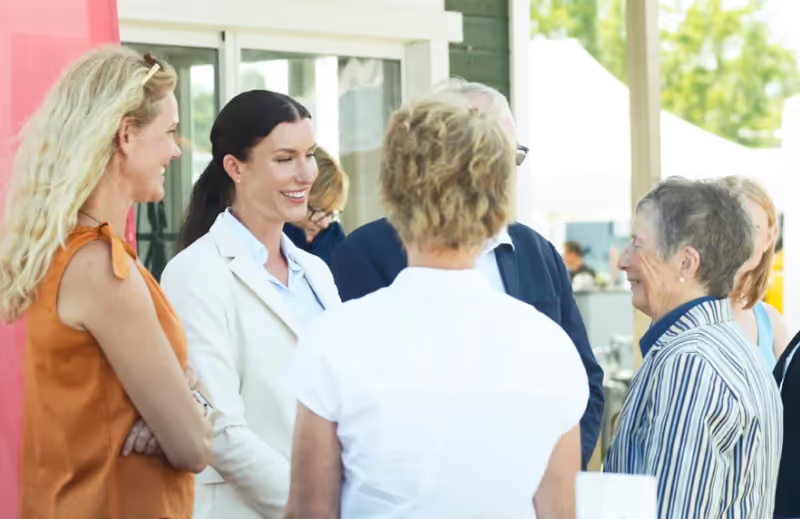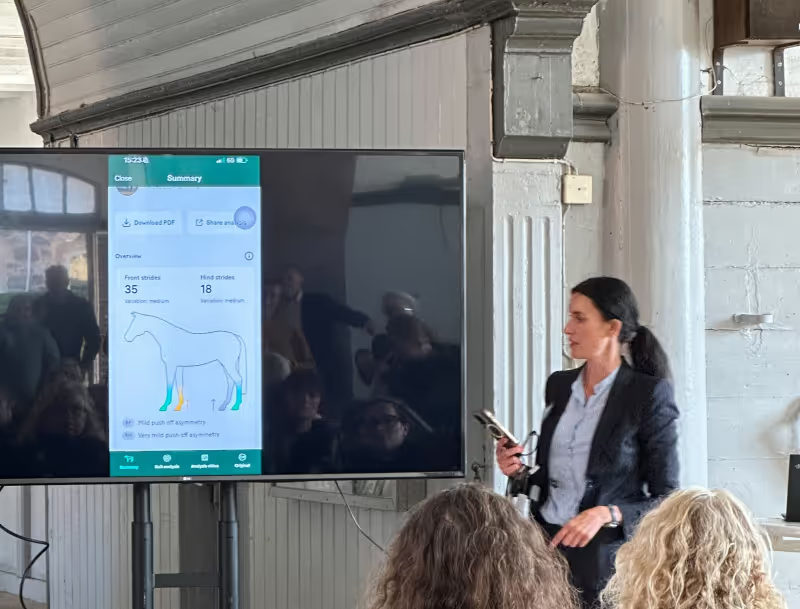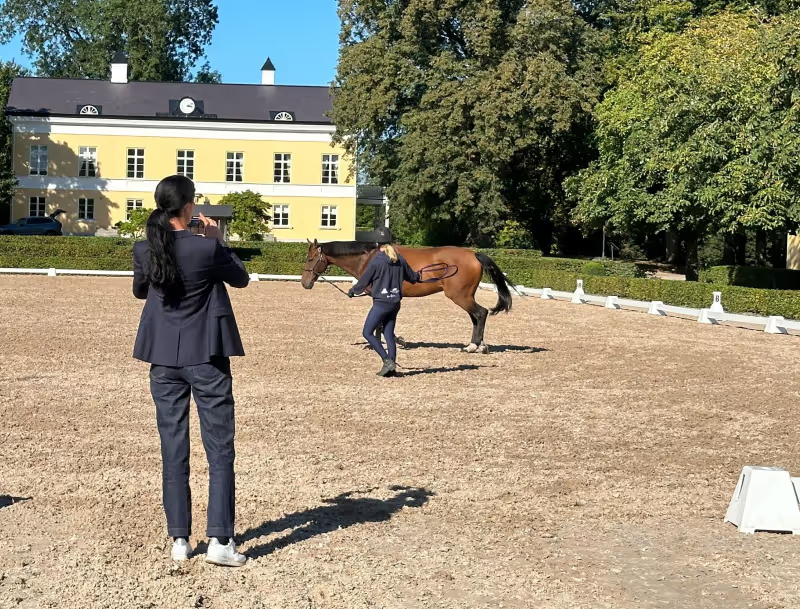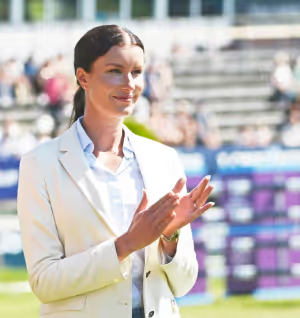
24 October 2024
It was a great success, bringing together people from all over the world, with diverse backgrounds, for an open discussion on equine welfare. It provided an opportunity to both discuss new research and exchange knowledge, which is key as we strive for even higher standards of equine welfare.
I gave a lecture and a demonstration, with the theoretical part held in Klockstallet and the practical parts in Stora Hingststallet and outdoors at Kastanjegården. My lecture, titled “Gait Screening using a Mobile Phone Application” covered various objective systems available for gait analysis, with a detailed explanation of Sleip – including how it works and how it’s applied in practice.
There was also an insightful conversation about the research I’m conducting with SLU ( Swedish University of Agricultural Sciences), Riksanläggningarna (Swedish Equestrian Centers of Excellence), and the Ulla Håkansson Foundation – “Smart Choices for Sustainable Horses”.

There is a great deal of interest in how we work with monitoring. Before beginning my research, I spent five years as head veterinarian responsible for the horses at the national equestrian centre Flyinge. It was during that time that I started using objective gait analysis to monitor horse health and focus on preventative care.
All the horses at Flyinge have been “Sleip-ed” since 2021, giving us a solid foundation for understanding each individual’s unique movement patterns.
We had many discussions about treatment, training plans, and active rest. Here, it is important to emphasize that regular veterinary work is the foundation we rely on. Monitoring the horses is a vital supplement in our daily efforts with equine health, but it cannot replace veterinary care. What it does offer is an additional layer of monitoring that helps us spot small deviations at an early stage. This is particularly helpful and important when you don’t have a vet examining your horse daily. Sleip supports improved and more frequent documentation, serving as an excellent complement to the team. Any system that helps increase equine welfare in any way is an excellent tool!
Often, veterinarians deal with lameness when it’s already a bit too late. I’ve been fortunate to specialize in preventative health care, both during my time at Flyinge and now in my work with high-level sport horses.
When I was responsible for the horses at Flyinge, we had a system where the students in the equine studies and professional riders programmes measured the horses once a week using Sleip. I was responsible for reviewing the analyses, and if anything deviated from the horse’s normal movement pattern, I would schedule them for clinical examination and lameness evaluation.

It’s similar to a traditional lameness investigation with trotting in a straight line and longeing, as well as flexion tests. Additionally, there is a clinical examination that involves palpating the locomotor system. Communication with the horse’s team is key. How has the shoeing been working? How does the horse feel during riding? Has the horse shown any deviations during the daily inspection?
If the horse is lame, a more thorough lameness investigation follows to diagnose the cause. In cases of mild asymmetry, the next step may involve on management and how the horse is ridden. Rest, modified training plans, changes in shoeing, physiotherapy, and rehabilitation are some examples of how the approach can be adjusted to strengthen the horse’s weaknesses.
Much has been written about the long-term research study “Smart Choices for Sustainable Horses,” which will continue until 2027. The main aim is to find ways to prevent and detect injuries and diseases in the horse’s locomotor system at an early stage.
Within this six-year project, I will conduct several sub-studies. The one that has garnered the most attention recently involves looking at the interaction between rider and horse during different phases of the jump: approach, elevation, take off, bascule, landing and recovery. A group of elite riders at a high level has gathered here at Flyinge, and we are examining the rider’s position and the horse’s biomechanics, seeking to understand the relationship between the two.The engagement from the riders has been immense and invaluable, and we hope to present findings that will benefit both horse and rider in the future.
Another sub-study we are working on examines workload and movement asymmetry. We have several years of longitudinal data where the horses are measured weekly, and we review training data, aiming to find correlations. We also have a study we call the Pasture study, where we have looked at school horses at Flyinge and Strömsholm, before and after pasture. Here, we are examining how active rest can affect movement asymmetry, incorporating factors such as shoeing, hoof condition, the horse’s age, pasture period, and previous medical history. Furthermore, we have pilot projects where we study the correlation between hoof shape and movement asymmetry.
For veterinarians, farriers, trainers, physiotherapists, and professional riders, it is incredibly important to collaborate effectively. Collaboration is an essential cog in the wheel of equine welfare and performance, but always with a veterinarian making the final judgement.
In general, I’m a big believer in training the horses. I don’t think you should be too afraid of movement - movement is good!
Smart choices for sustainable horses - can strategic movement monitoring, training regimens, and planned rest optimize the orthopaedic sustainability of riding horses? is a PhD study focusing on how the type, intensity, and variation of training affect the symmetry of horse movement. Other management factors, such as shoeing, will also be studied in relation to movement asymmetry. The study is managed by Isabelle Fredricson and supervised by Elin Hernlund, DVM, Associate professor at the Swedish University of Agricultural Sciences (SLU) and co-founder of Sleip. It is funded by the Ulla Håkansson Foundation, SLU and Flyinge and runs from 2023-2027.
Horse Welfare Summit Flyinge is Northern Europe’s largest event focusing on horse welfare. The focus is on the horses’ behaviour and mental wellness in connection to training and working with horses. The summit took place at Flyinge, 13-14 Sep 2024.
DVM, IVCA-certified chiropractor, FEI PTV and researcher at the Swedish National Equestrian Centre Flyinge
